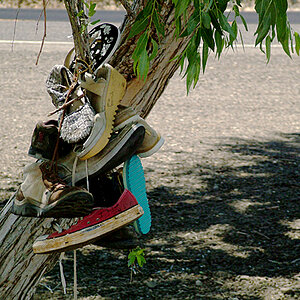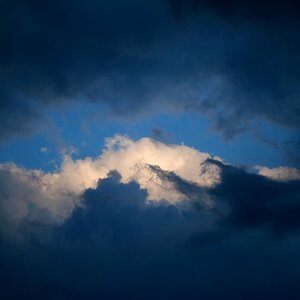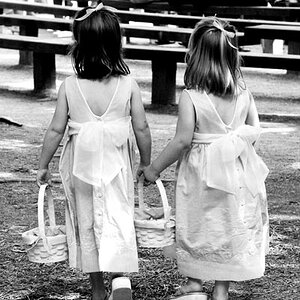Navigation
Install the app
How to install the app on iOS
Follow along with the video below to see how to install our site as a web app on your home screen.

Note: This feature currently requires accessing the site using the built-in Safari browser.
More options
You are using an out of date browser. It may not display this or other websites correctly.
You should upgrade or use an alternative browser.
You should upgrade or use an alternative browser.
Sony announced new f2.8 lenses
- Thread starter goodguy
- Start date
- Joined
- Jun 7, 2012
- Messages
- 15,469
- Reaction score
- 7,848
- Location
- Central Florida
- Website
- www.flickr.com
- Can others edit my Photos
- Photos NOT OK to edit
So far all the "advantages" are trivial at best.
mirrorless camera or older women?
IronMaskDuval
Been spending a lot of time on here!
- Joined
- Mar 9, 2014
- Messages
- 1,396
- Reaction score
- 506
- Location
- United States
- Can others edit my Photos
- Photos OK to edit
So far all the "advantages" are trivial at best.
I don't think the ability to buy a premium prime for $50 is trivial. Many members on this forum complain that manual focus is difficult because of old eyes. Focus peaking addresses this issue and allows a photographer to buy a premium optic at a premium discount. That's not trivial.
cherylynne1
No longer a newbie, moving up!
- Joined
- Dec 8, 2015
- Messages
- 663
- Reaction score
- 254
- Website
- www.flickr.com
- Can others edit my Photos
- Photos OK to edit
So far all the "advantages" are trivial at best.
And that's exactly how I feel about DSLRs. So I'm glad there are enough different cameras that you and I can both be happy.
cherylynne1
No longer a newbie, moving up!
- Joined
- Dec 8, 2015
- Messages
- 663
- Reaction score
- 254
- Website
- www.flickr.com
- Can others edit my Photos
- Photos OK to edit
So whats the advantage of mirrorless if not the size? Frankly thus far there are none that I can think of.
Well, size is still there. Perhaps not weight, but the hands' wrap around is much more compact. Real exposure in the EVF is another. Another is focus peaking and magnification, which gives the nexus advantage of using legendary vintage lenses. Manual focus was once considered slow, but with focus peaking, it's just as fast, if not pretty close to AF. I was a dslr whore, but when I touched my first MILC, I knew the advantages right off bat once I learned how to use the camera.
totally agree. I remember the first time I touched one too. the advantages were pretty obvious. how my hands wrapped around it. the exposure. the peaking...
you did mean that to be an "F" there and not a "C", right? the way you wrote it i just assumed a typo. =)
*facepalm* Took me ten minutes to get this.
IronMaskDuval
Been spending a lot of time on here!
- Joined
- Mar 9, 2014
- Messages
- 1,396
- Reaction score
- 506
- Location
- United States
- Can others edit my Photos
- Photos OK to edit
So whats the advantage of mirrorless if not the size? Frankly thus far there are none that I can think of.
Well, size is still there. Perhaps not weight, but the hands' wrap around is much more compact. Real exposure in the EVF is another. Another is focus peaking and magnification, which gives the nexus advantage of using legendary vintage lenses. Manual focus was once considered slow, but with focus peaking, it's just as fast, if not pretty close to AF. I was a dslr whore, but when I touched my first MILC, I knew the advantages right off bat once I learned how to use the camera.
totally agree. I remember the first time I touched one too. the advantages were pretty obvious. how my hands wrapped around it. the exposure. the peaking...
you did mean that to be an "F" there and not a "C", right? the way you wrote it i just assumed a typo. =)
*facepalm* Took me ten minutes to get this.
I'm so confused.
cherylynne1
No longer a newbie, moving up!
- Joined
- Dec 8, 2015
- Messages
- 663
- Reaction score
- 254
- Website
- www.flickr.com
- Can others edit my Photos
- Photos OK to edit
So whats the advantage of mirrorless if not the size? Frankly thus far there are none that I can think of.
Well, size is still there. Perhaps not weight, but the hands' wrap around is much more compact. Real exposure in the EVF is another. Another is focus peaking and magnification, which gives the nexus advantage of using legendary vintage lenses. Manual focus was once considered slow, but with focus peaking, it's just as fast, if not pretty close to AF. I was a dslr whore, but when I touched my first MILC, I knew the advantages right off bat once I learned how to use the camera.
totally agree. I remember the first time I touched one too. the advantages were pretty obvious. how my hands wrapped around it. the exposure. the peaking...
you did mean that to be an "F" there and not a "C", right? the way you wrote it i just assumed a typo. =)
*facepalm* Took me ten minutes to get this.
I'm so confused.
He's saying you made a typo in "MILC."
I giggled, but mostly because I was so proud of myself for figuring it out.
- Joined
- Oct 16, 2012
- Messages
- 14,632
- Reaction score
- 7,562
- Can others edit my Photos
- Photos OK to edit
So far all the "advantages" are trivial at best.
I don't think the ability to buy a premium prime for $50 is trivial. Many members on this forum complain that manual focus is difficult because of old eyes. Focus peaking addresses this issue and allows a photographer to buy a premium optic at a premium discount. That's not trivial.
Focus peaking is not the greatest thing in the world as it struggles in bright light and low light.
Solarflare
No longer a newbie, moving up!
- Joined
- May 24, 2012
- Messages
- 2,898
- Reaction score
- 395
Sony starts actually stealing market share from Canikon, thus it would make sense that Canikon should and probably will start moving soon.Oh they will and switching to mirrorless isn't the big deal people think it is. Canon and Nikon will do just fine if they stay the course and let Sony do all the legwork in figuring out how to make a mirrorless camera that professionals want to use.
Its not hard to specify what professionals want to use. I doubt Canikon has any need to let Sony check the waters in this respect. Besides, they neither gain the knowhow nor the production capabilities for mirrorless if they use Sony as a scout this way.
Their only motive not to publish a mirrorless system is not to hurt their DSLR sales. They have a huge stack of investments in DSLRs they want to protect, including an extensive inventory of lenses and lens production capabilities. And all this in a shrinking market.
The two main challenges of mirrorless still havent been satisfyingly universally solved:
(a) Autofocus performance. While the systems are getting better, DSLR autofocus is still ahead of mirrorless. Solutions are the advanced contrast autofocus of Panasonic (currently requires knowing the exact behavior of the lens, but a learning algorithm could be possible) and phase detection pixels, up to the dualpixel technology of Canon.
(b) Sensors that can handle steep angles of light. Panasonic just published a paper that claimed they can manage now 60 degrees with their newest technology. That would be a highly satisfying performance. But when will actual products appear ?
Well, no.With the mirror box gone, what we have is basically a DSLR in Live View mode. But with the EVF-equipped cameras, we’re not restricted to just the rear screen—we can use the same Live View in the eye-level viewfinder. This is the difference between DSLR and mirrorless cameras, not size.
Theres a *lot* of differences between SLR and MILC. Including *size* - the lack of a mirrorbox allows more compact and higher quality wide angle lenses - assuming that the sensor can handle more steep angles of light.
EVF however - is not one of them. A SLR could have an EVF in lifeview mode. There is absolutely no technical issue stopping anyone adding an EVF to a SLR this way. I have demanded this feature since years and I see other people demand this feature since years. For example I was hoping the Nikon Df would have this feature, given what kind of camera it is.
For starters it would allow using a lot of great lenses that are however manual in a much more comfortable way, allowing both focus peaking and 100% magnification (and, if the sensor has a feature like dualpixel, also digital split screen) for critical focusing. Old Nikon pre-AI/AI/AI-S lenses, Zeiss and Voigtländer lenses (of course also available for Canon), PC-E lenses (or TS-E for Canon) etc could all be used in a very reliable way. With a mechanism to move the sensor forward for the required shorter flange distance, even adapting mirrorless lenses could be possible.
It also would allow much more comfortable video recording. Good video recording with a SLR is another example for something that could be implemented at any time - the camera producers simply choose not to do so.
The only reason why SLRs do not have an EVF is because the camera producers dont want to add one. Just like mirrorless can have an energy-saving OVF - even if Leica M and Fuji X-Pro are the only two cases that actually do so (and only the Leica M has an OVF that DSLR-like doesnt use any current at all).
Sony wont replace the D5/1D-X2 any time soon. Maybe never.Give those D5/1D-X and D810/5D-S/5D-III a comparable camera with Live View in the viewfinder, and surround it with the lenses they need.
This would be hopelessly futile. Because outside propaganda Sony currently cant offer them the required Autofocus performance as well. The only camera that theoretically can do it in good enough light (apparently up to EV 3) is the A7r II, but from what I heard, this camera doesnt offer enough reliability - the camera very phrone to stall and even worse somewhat phrone to crash.
Replacing the D810 is more likely, especially if no higher autofocus performance is required.
Professionals however are a very small part of the camera market. Thus Sony stands a good chance with richer hobbyists who dont mind the extra hassle from such obstacles.
Mirrorless has some strong advantages over SLRs, but SLRs also have some strong advantages over mirrorless. In the very long run, once all the issues of mirrorless are solved, I see mirrorless dominating, but I think SLR will stay, just like rangefinder still stays, maybe better (specifically wildlife and maybe also action shooters might keep using DSLRs).So whats the advantage of mirrorless if not the size? Frankly thus far there are none that I can think of.
+ Size definitely is an advantage of mirrorless, only much less than people seem to assume. The major factor of the smaller size of mirrorless are because the sensors are smaller, and in case of Leica, because the lenses dont have to contain autofocus (same for Zeiss Loxia lenses); Sony FE lenses however arent smaller than DSLR lenses per se and often have to be longer. However, mirrorless definitely loses the mirror box and the parts of DSLRs linked to that mirrorbox, namely the pentaprism and other OVF parts including the metering sensor above the mirror box and the AF system below the mirror box. Instead Mirrorless needs space for an EVF and possibly larger batteries, though, though many mirrorless cameras currently instead offer a lot less shots per battery.
+ Mirrorless cameras have a magnitude less parts because the mirrorbox of a modern DSLR is actually a very complicated thing. This makes mirrorless cameras much simpler, more robust, and cheaper. Especially the cheaper part currently cannot be seen in actual cameras because the DSLRs have the advantage in sheer production numbers.
+ If the sensor can handle steep angles of light, wide angle lenses can avoid retrofocus in their optical formula and can thus be made with less elements, smaller, more lightweight, cheaper, and with higher quality.
+ EVF can allow you a view compareable to a medium format OVF even if the sensor is small. They offer perfect 100% framing (one of the reasons why to use lifeview on a DSLR is to get perfectly accurate framing of a shot).
+ If they have an OVF, its rangefinder style ... not really a clear advantage, but an advantage to some types of photography (candid, street).
+ With an EVF, theres a huge number of possibilities, basically only limited by your imagination. Focus Peaking, Magnification, Digital Split Screen, Zebras, Life Histogram, False Colors etc. Of course you can have all that with a DSLR put into lifeview mode, assuming you give the DSLR an EVF during lifeview mode.
+ Since AF is usually contrast or combined contrast with phase, the AF system doesnt need calibration and can be made very reliable.
Issues of mirrorless:
- MILC use a lot more current than DSLR. Specifically they use current all the time. A huge issue for people who want to lie still waiting for their "prey" for hours, namely wildlife shooters.
- Good EVFs are still quite expensive, and the best also require quite a bit of space. EVF currently still have a lot of issues - still some lag, cant handle low light well, too low resolution, flickering with artificial light, and some people with especially poor eyes report they can use OVF, but not EVF.
- AF performance, especially with action in low light, is still clearly inferior to the best DSLRs.
IronMaskDuval
Been spending a lot of time on here!
- Joined
- Mar 9, 2014
- Messages
- 1,396
- Reaction score
- 506
- Location
- United States
- Can others edit my Photos
- Photos OK to edit
So far all the "advantages" are trivial at best.
I don't think the ability to buy a premium prime for $50 is trivial. Many members on this forum complain that manual focus is difficult because of old eyes. Focus peaking addresses this issue and allows a photographer to buy a premium optic at a premium discount. That's not trivial.
Focus peaking is not the greatest thing in the world as it struggles in bright light and low light.
I can agree with that contention as it applies to Fuji and Oly, but Sony's focus peaking works just fine in low and high light.
- Joined
- Oct 16, 2012
- Messages
- 14,632
- Reaction score
- 7,562
- Can others edit my Photos
- Photos OK to edit
So far all the "advantages" are trivial at best.
I don't think the ability to buy a premium prime for $50 is trivial. Many members on this forum complain that manual focus is difficult because of old eyes. Focus peaking addresses this issue and allows a photographer to buy a premium optic at a premium discount. That's not trivial.
Focus peaking is not the greatest thing in the world as it struggles in bright light and low light.
I can agree with that contention as it applies to Fuji and Oly, but Sony's focus peaking works just fine in low and high light.
Not with mine it doesn't
Ido
No longer a newbie, moving up!
- Joined
- Jun 30, 2014
- Messages
- 449
- Reaction score
- 67
- Location
- Israel
- Can others edit my Photos
- Photos NOT OK to edit
Not everyone likes using the optical viewfinder. While I haven't used an SLR extensively at all, I definitely appreciate the EVF on my camera. I hate shooting with the rear LCD, so I always use the eye-level viewfinder, but I like the advantages of Live View for my shooting. Mainly, it helps me get the optimum exposure for raw files every time, without any guesswork.So whats the advantage of mirrorless if not the size? Frankly thus far there are none that I can think of.
Now that would be awesome, giving photographers the choice in one camera, and having the best of both worlds. Need to shoot fast action, with fast continuous autofocus and absolutely no lag in the viewfinder? Use the optical one. Prefer LV and don't want to use the rear screen? Switch on the EVF. And switch between them as needed.A SLR could have an EVF in lifeview mode. There is absolutely no technical issue stopping anyone adding an EVF to a SLR this way. I have demanded this feature since years and I see other people demand this feature since years. For example I was hoping the Nikon Df would have this feature, given what kind of camera it is.
For starters it would allow using a lot of great lenses that are however manual in a much more comfortable way, allowing both focus peaking and 100% magnification (and, if the sensor has a feature like dualpixel, also digital split screen) for critical focusing. Old Nikon pre-AI/AI/AI-S lenses, Zeiss and Voigtländer lenses (of course also available for Canon), PC-E lenses (or TS-E for Canon) etc could all be used in a very reliable way. With a mechanism to move the sensor forward for the required shorter flange distance, even adapting mirrorless lenses could be possible.
It also would allow much more comfortable video recording. Good video recording with a SLR is another example for something that could be implemented at any time - the camera producers simply choose not to do so.
The only reason why SLRs do not have an EVF is because the camera producers dont want to add one. Just like mirrorless can have an energy-saving OVF - even if Leica M and Fuji X-Pro are the only two cases that actually do so (and only the Leica M has an OVF that DSLR-like doesnt use any current at all).
Who knows, maybe an R&D team at Canon or Nikon is already working on this! I highly doubt it, but if, in the next few years, mirrorless cameras basically take over the entire market except the sports/action photographers, we could see Canon/Nikon implementing this feature and make a truly hybrid camera.
I was speaking more about the long-term, the possibilities. Technology is only getting better and better—look how much better continuous AF in mirrorless cameras is now than it was 3, 4, 5 years ago! It may never actually reach the level of current top-end DSLRs, but it surely will come close enough at some point to be more than adequate for pretty much any use case.Sony wont replace the D5/1D-X2 any time soon. Maybe never.
This would be hopelessly futile. Because outside propaganda Sony currently cant offer them the required Autofocus performance as well. The only camera that theoretically can do it in good enough light (apparently up to EV 3) is the A7r II, but from what I heard, this camera doesnt offer enough reliability - the camera very phrone to stall and even worse somewhat phrone to crash.
- Joined
- Jun 2, 2013
- Messages
- 4,493
- Reaction score
- 4,141
I've been considering moving from Canon to Nikon, and never really considered Sony. I may have to give Sony a chance.
Last edited:
Similar threads
- Replies
- 7
- Views
- 599
- Locked
- Replies
- 26
- Views
- 4K
- Replies
- 5
- Views
- 512

![[No title]](/data/xfmg/thumbnail/41/41932-53eeba896d5bf8f132e52d5277f94ce2.jpg?1619739946)
![[No title]](/data/xfmg/thumbnail/41/41929-26c4134c150c4c6befd5f544a5223aaf.jpg?1619739946)



![[No title]](/data/xfmg/thumbnail/41/41928-733459df56e3fa2fe957f910305d4e37.jpg?1619739945)





